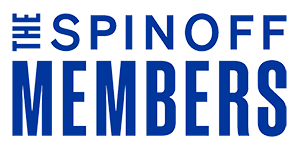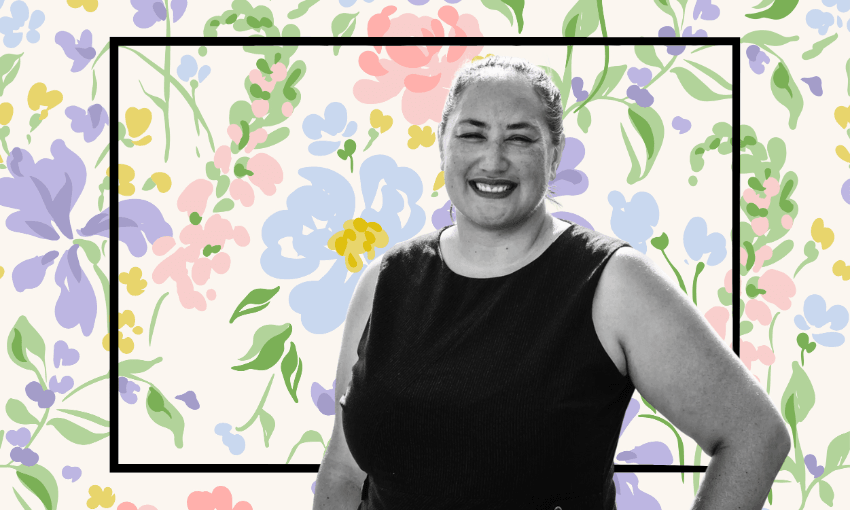Brian Tamaki’s latest protest didn’t just target minority communities – it co-opted haka, taiaha and moko to do it. When Māori culture is used to push a hateful agenda, we need to call it what it is: cultural appropriation in service of extremism.
There I was, stuck in my Covid isolation room doomscrolling through social media on a Saturday afternoon. Among the plethora of comments about humanity being on the verge of another world war and excitement for the Warriors game that evening, I saw a video shared with the following caption: “Oh dear! Using Māori culture to advance an agenda of fundamentalism, terrorism, and pōrangitanga.”
I clicked on it and soon realised I had joined a livestream of approximately 500 Destiny Church members marching up Queen Street. I didn’t even know the march was happening, nor why, but what I saw only strengthened my disdain for Brian Tamaki and his church. Leading the crowd is a group of young Māori, a majority of them men, dressed in maro, with red paint on their thighs, stenciled mataora on their faces, and black rākau in their hands. Behind them, six more rows of people – dressed mostly in black Destiny Church apparel – begin to haka in unison.
At the conclusion of the fiery haka, supreme leader Brian Tamaki takes the microphone. He speaks to the crowd – which I imagine is mostly made up of bemused onlookers otherwise in the area – about the evils of the world. Several New Zealand flags fly behind him, alongside a banner that reads: “NZs Official Religion: Christianity”.
“This is the beginning of the pushback from the Commonwealth countries and the Christian nation here in the southern hemisphere,” Tamaki begins.
He goes on to talk about how they are taking back their countries from “evil people” who are trying to take away their “homes, future and faith”. Over the next 15 minutes, there is mention of wars against religion, other gods attempting to take over, and the price of butter. Tamaki proclaims the national anthem is “an embarrassment” and says the New Zealand flag isn’t flown enough.
The whole time Tamaki is speaking, the group behind him gesticulates and posturises – they pull pūkana, wander around with their traditional Māori weapons, and let out cries. Then appear flags: Islam, Palestine, Khalistan, Sikh, Buddhist, Hindu, United Nations, World Health Organisation, World Economic Forum, Atheist, Rainbow, and Transgender. One-by-one, each flag is torn in two as Tamaki explains why they are evil. After each flag, a short haka takes place: “Upokokōhua! Kai a te kurī!” These terms are the equivalent of Māori curse words, the first referring to a boiled head and second to dog’s food.
To conclude there are two large pieces of paper – the first has 12 different New Zealand news media outlets on it. After a comical attempt by two of Tamaki’s followers to light it on fire, the paper is torn in half. Then appears a large printout of the cover of Jacinda Ardern’s newest biography A Different Kind of Power, which is also torn in half. Young men circle the remnants, posturing with taiaha, yelling into the camera.
It was absurd. But it was also insidious. This is Destiny Church’s attempt to break the spirit of these movements and communities. The livestream ends with Tamaki continuing to speak. I don’t bother searching for another one.
The self-proclaimed apostle would be well aware the number of Destiny Church members dwindles in comparison to these groups. The tearing of flags is nothing more than a symbolic gesture, especially considering a majority of those present were already members of the church. This all would have done little to “break the spirit” of the movements and organisations Tamaki was condemning. So besides public condemnation, what’s the point?
Well, my hypothesis is that the whole spectacle was nothing more than a fearmongering exercise and attempt from Tamaki to boost dwindling membership numbers and garner support leading into next year’s general election. Mention of British anti-Islam campaigner Tommy Robinson and “the biggest protest the world has ever seen” in England this September shows Tamaki is attempting to further align himself with global extremists.
This wasn’t a haka – it was a hijacking. It was a weaponisation of Māoritanga. Destiny Church continually co-opts Māori culture – haka, moko, taiaha, pūkana – and twists it into an instrument of intimidation. The performance wasn’t about pride in whakapapa. It was about vilifying anyone who didn’t fit Brian Tamaki’s Christian nationalist worldview. This is where things get dangerous.
Tamaki often blurs the line between Christian identity and cultural identity – and not by accident. His entire aesthetic often relies on the illusion that Māoritanga and Christianity are one and the same, and that to be Māori is to support his particular brand of fundamentalism. The result? Viewers unfamiliar with tikanga may associate haka, moko and taiaha with aggression, exclusion and intolerance – rather than with cultural pride, resilience and manaakitanga.
I don’t deny that some haka are rooted in conflict, but the confusion has real-world consequences. Young people watching that livestream could be left thinking that te ao Māori is inherently anti-queer. That to be proud in their culture, they must also hate Muslims, Buddhists or Hindus. That standing strong as Māori means tearing down others. It’s not just hateful. It’s a distortion.
There’s a crucial distinction that Destiny Church refuses to make – perhaps because its entire strategy depends on erasing it. Māori identity is not a religion. Māoritanga is not Christianity. You can be Māori and Muslim. Māori and Buddhist. Māori and takatāpui. You can be Māori and Christian too, even a Māori member of Destiny Church, but don’t use our culture to desecrate the flags of other faiths while shouting offensive kupu and performing haka with hate in your heart.
You don’t get to drape yourself in maro and claim you stand for all Māori. Especially when you’re using that platform to attack the very values that underpin our culture: inclusion, whanaungatanga, aroha and manaaki. As Ngāti Pāoa’s health service E Tipu e Rea put it in a release: “Our tikanga teaches us to uplift, to manaaki, and to protect the dignity of all people… what we witnessed was a weaponisation of our culture to spread hate.”
The symbolism wasn’t lost on others either. Multiple ethnic and faith organisations have since spoken out. The Federation of Islamic Associations, the Combined Sikh Association, the NZ Buddhist Council, and dozens more condemned the protest. “This is not an exercise of free speech,” one joint statement read. “This is targeted hate.” Melissa Derby, the race relations commissioner, said plainly in a release: “Brian Tamaki’s ‘us vs them’ narratives are a reckless attack on social cohesion.”
This isn’t about silencing religion. It’s about holding extremists accountable when they misuse platforms, symbols and cultural identities to push hate.
Brian Tamaki is free to preach whatever theology he wants in his church. What he doesn’t have the right to do is appropriate Māori cultural practices – many of them sacred – and use them as props in a political campaign that seeks to vilify other New Zealanders. That is not religious freedom. That’s cultural exploitation.
He may believe he’s waging a holy war. But from where I’m sitting – watching while he parades young Māori men in maro to tear down rainbow flags – it looks more like a desperate grab for relevance. A play to reinvigorate his crumbling congregation. A last gasp to position himself at the head of a fringe “Commonwealth crusade” that has no place in a country that values dignity, tolerance and diversity.



